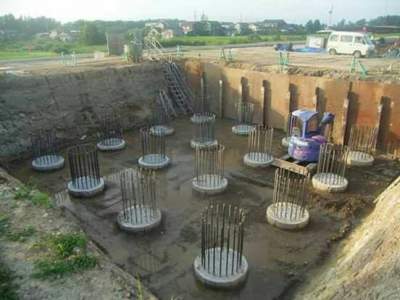Compared to other types of pile foundations, concrete piles are often erected as the foundation of many structures.
The article Pile foundations You can find more information about pile foundations here. In this article we will discuss concrete piles.
Why do we need batteries and when do we need batteries?
The following main reasons can be highlighted as prerequisites for the construction of pile foundations.
- Weak soil conditions
- To support buoyancy forces
- To withstand lateral forces
- If there is no possibility of absorbing the acting loads through the shallow foundation.
As we know, the most cost-effective type of foundation is the cushion foundation. If soil conditions are poor, it may not be possible to build a shallow foundation, even for a two-story building.
We could try soil stabilization method, or alternatively we could opt for a pile foundation if another method is not viable.
What is a concrete pile?
A pile is a reinforced concrete component that has a round, square or other shaped cross-section or is embedded deeper into the earth.


Types of concrete piles
There are mainly three types of concrete piles, of which prestressed concrete piles are not widely used in construction.
- In situ concrete bored piles
- Prefabricated piles or driven piles
- Prestressed Concrete Piles
Let's discuss each type of concrete pile in detail.
In situ concrete bored piles
The most commonly used type of concrete pile in construction is cast-in-place bored piles. Although the construction process is a little more complicated/difficult compared to other types of concrete piles, these types of pile foundations offer many additional benefits.
The biggest challenge in constructing in-situ concrete bored piles is quality control.
Bored piles are now available in diameters from 600mm to 3,000mm or even larger. The development of the construction industry has expanded the applicability of concrete piles.
Prefabricated piles
Prefabricated piles are also called driven piles. For more information about driven piles, see the article Driven pile Planning and construction of foundations.
Precast piles are comparatively simpler than cast-in-place bored piles. Furthermore, the construction process is not that complicated and the installation of the layers can be done quickly.


Comparison of in situ concrete piles and bored piles
| In situ concrete bored piles | Prefabricated piles | |
| 1 | The pile is dropped into place | Prefabricated piles are used |
| two | Mainly anchored in rock | Completed over a layer of hard soil, which is determined based on geotechnical capacity, which is evaluated based on soil parameters |
| 3 | Since it rests largely on the rock, a higher final disposition can be achieved | Comparatively, you can expect low-cost bearings |
| 4 | Rock surface friction can be taken into account | There was no friction as the post ended above the curved rock. |
| 5 | They have greater resistance to buoyancy | Comparatively low buoyancy resistance |
| 6 | Casting inclined piles is a challenge | The prefabricated pile can be driven at an angle |
| 7 | Completing the pile foundation is a challenge | Completion can be carried out taking into account the settlement of the heads during driving. |
| 8th | Circular shape | Usually square shape |
| 9 | As the diameter increases, a greater axial load capacity can be achieved | There are limitations on axial capacity because it is difficult to increase the pile size |
| 10 | The quality control and assurance process is very important because the pile is driven underground and visual observation is not possible. | As the pile is driven into place, the construction quality can be monitored. |
| 11 | The diameter of the pile may change during construction due to soil collapse (bulging and necking). The integrity of the pile is checked after the construction phase. | The pile may cause structural damage during the driving process. |
| 12 | Construction costs would be higher than with other pile foundations | Construction costs would be lower than with in situ concrete piles |
| 13 | It takes a long time to complete the construction of piles | Comparatively shorter construction time |
Application of different types of concrete piles
- In-situ concrete bored piles are used in high-rise construction
- Prefabricated piles would be used in buildings with low axial loads.
- Driven or precast piles are used in areas where graded piles are present
- Construction of bridges and prefabricated piles are being processed
Concrete pile testing
To guarantee the construction quality and load capacity of the piles, the following tests are carried out.
| Test type | Test type |
| Continuous Load Testing (MLT) | To check the load capacity of the pile |
| Stack Integrity Test (PIT) | Check battery integrity. The test allows you to determine if the post is connected correctly, if there are constrictions, bulges, etc. |
| Dynamic Pile Testing (PDA) | To check the load capacity of the pile |
| Cross Hole Sonic Integrity Test for Wood Poles | Check the integrity of the pile with the reinforcing cage. |
| Bidirectional Pile Loading Tests | To check the load capacity |
You can find more articles about pile foundations here
- Pile slab foundations
- Problems and solutions in the construction of pile foundations
- Stack Design (Things to Remember)
- Pile design (draft detailed instructions)

